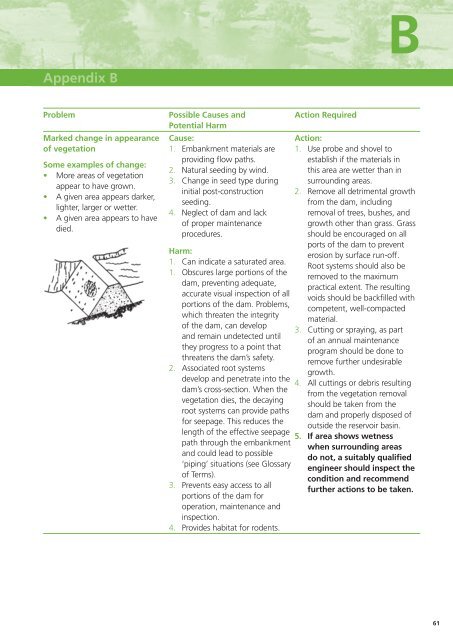Your Dam Your Responsibility (PDF~1.2MB)
Your Dam Your Responsibility (PDF~1.2MB)
Your Dam Your Responsibility (PDF~1.2MB)
You also want an ePaper? Increase the reach of your titles
YUMPU automatically turns print PDFs into web optimized ePapers that Google loves.
Appendix B<br />
Problem Possible Causes and<br />
Potential Harm<br />
Marked change in appearance<br />
of vegetation<br />
Some examples of change:<br />
• More areas of vegetation<br />
appear to have grown.<br />
• A given area appears darker,<br />
lighter, larger or wetter.<br />
• A given area appears to have<br />
died.<br />
Cause:<br />
1. Embankment materials are<br />
providing flow paths.<br />
2. Natural seeding by wind.<br />
3. Change in seed type during<br />
initial post-construction<br />
seeding.<br />
4. Neglect of dam and lack<br />
of proper maintenance<br />
procedures.<br />
Harm:<br />
1. Can indicate a saturated area.<br />
1. Obscures large portions of the<br />
dam, preventing adequate,<br />
accurate visual inspection of all<br />
portions of the dam. Problems,<br />
which threaten the integrity<br />
of the dam, can develop<br />
and remain undetected until<br />
they progress to a point that<br />
threatens the dam’s safety.<br />
2. Associated root systems<br />
develop and penetrate into the<br />
dam’s cross-section. When the<br />
vegetation dies, the decaying<br />
root systems can provide paths<br />
for seepage. This reduces the<br />
length of the effective seepage<br />
path through the embankment<br />
and could lead to possible<br />
‘piping’ situations (see Glossary<br />
of Terms).<br />
3. Prevents easy access to all<br />
portions of the dam for<br />
operation, maintenance and<br />
inspection.<br />
4. Provides habitat for rodents.<br />
Action Required<br />
B<br />
Action:<br />
1. Use probe and shovel to<br />
establish if the materials in<br />
this area are wetter than in<br />
surrounding areas.<br />
2. Remove all detrimental growth<br />
from the dam, including<br />
removal of trees, bushes, and<br />
growth other than grass. Grass<br />
should be encouraged on all<br />
ports of the dam to prevent<br />
erosion by surface run-off.<br />
Root systems should also be<br />
removed to the maximum<br />
practical extent. The resulting<br />
voids should be backfilled with<br />
competent, well-compacted<br />
material.<br />
3. Cutting or spraying, as part<br />
of an annual maintenance<br />
program should be done to<br />
remove further undesirable<br />
growth.<br />
4. All cuttings or debris resulting<br />
from the vegetation removal<br />
should be taken from the<br />
dam and properly disposed of<br />
outside the reservoir basin.<br />
5. If area shows wetness<br />
when surrounding areas<br />
do not, a suitably qualified<br />
engineer should inspect the<br />
condition and recommend<br />
further actions to be taken.<br />
61


